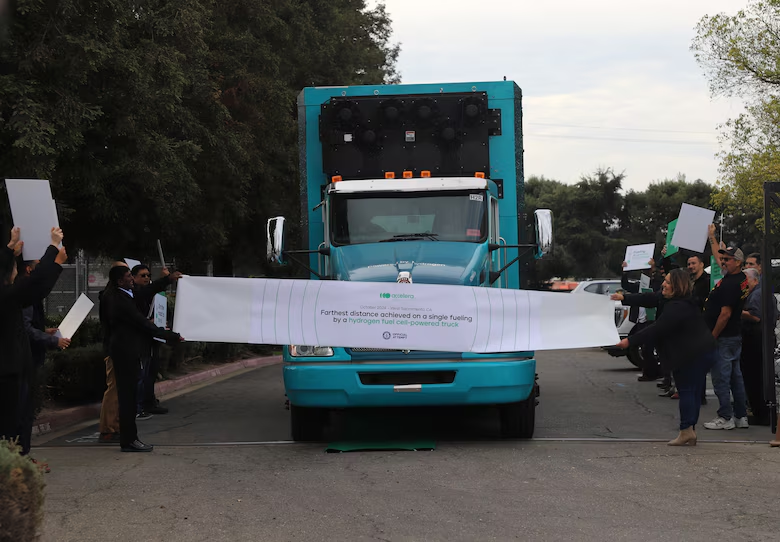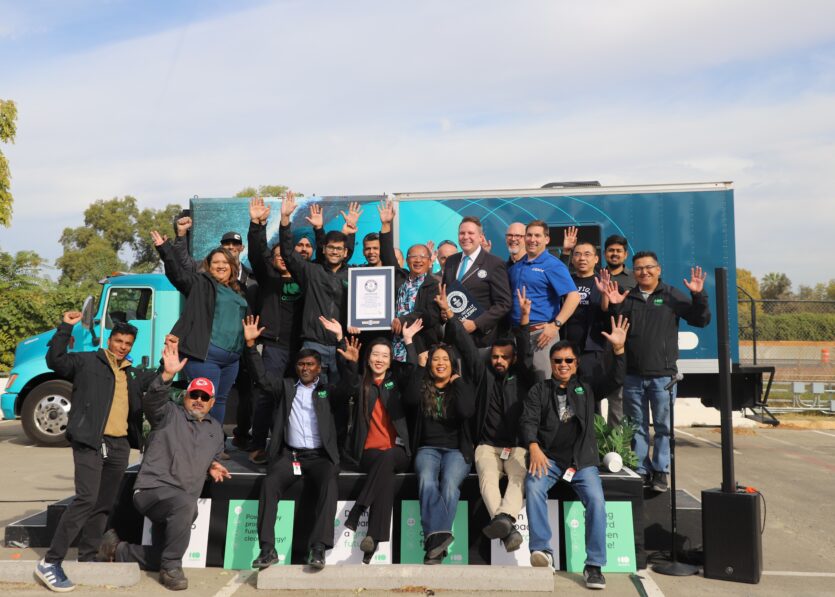Hydrogen-powered truck sets world record for longest distance traveled without refueling.
Hydrogen-Powered Heavy-Duty Truck Establishes New Threshold by Traveling 1,800 Miles on a Single Fill.
Accelera by Cummins, funded in part by the U.S. Department of Energy, sets new Guinness World Record mark, emits zero carbon dioxide in the process.
The U.S. Department of Energy’s (DOE’s) Hydrogen and Fuel Cell Technologies Office (HFTO) today highlighted a recent groundbreaking achievement in hydrogen-powered transportation: a prototype H2Rescue truck, built and powered by Accelera with funding support from DOE and other federal agency partners, last month established a new world record by traveling 1,806 miles on a single fill of hydrogen fuel.
The truck completed its record-setting journey in California and was closely monitored and validated by an adjudicator from Guinness World Records who confirmed the truck’s hydrogen tank was sealed before the journey began. Powered by a Cummins Accelera fuel cell engine and a 250-kilowatt traction motor, the truck carried 175 kilograms of hydrogen and consumed 168 kilograms while navigating rush hour traffic, between 50 to 55 mph, on public roads, operating in temperatures varying from 60 to 80 degrees Fahrenheit. Accelera researchers confirmed that over the 1,800-mile trip, the hydrogen-filled truck emitted zero pounds of carbon dioxide (CO2), a stark contrast to the 664 pounds of CO2 a standard internal combustion engine vehicle would have emitted over the same distance.

Using hydrogen in this type of truck—which is typically used in emergency response, military, and utility applications—can displace approximately 1,825 gallons of fuel and reduce greenhouse gas emissions by 2.5 metric tons annually. This demonstration vehicle, weighing approximately 33,000 pounds, is the result of an innovative collaboration between Accelera, HFTO, DOE’s Vehicle Technologies Office, the U.S. Department of Homeland Security’s Science and Technology Directorate, the Federal Emergency Management Agency, and the U.S. Department of Defense.
“This is such a great accomplishment,” said Nick Josefik, an ERDC-CERL industrial engineer and H2Rescue team lead. “This project started with an idea on paper when we saw some of the wildfires that were ravaging California. A group of researchers from the different federal agencies came together and said ‘how can we create something that could support those emergency situations,’ and now, five years later, that idea set a world record. Words cannot explain how amazing this accomplishment is for the H2Rescue team.”
This record-setting endeavor marks the introduction of a new category for GUINNESS WORLD RECORDS™ and was meticulously supervised by adjudicator Michael Empric. H2Rescue’s journey from Oakland, California, to West Sacramento, California, was conducted under strict regulations, with Empric verifying the truck’s hydrogen tank was sealed throughout the entire trip.
“With this world record, we’re showing that hydrogen can be a viable clean energy source for vehicle transportation, and it’s just so exciting to see what we accomplish when we work together,” Josefik shared. “Who knew that in 2019, when we drew this up on paper and started talking about it, that the culmination would be a world record, it is just very exciting.”
“This shows what partnerships between different federal agencies and the private sector can overcome and what we can achieve when we work together to develop these technologies to advance emergency preparedness and strengthen our nation’s ability to respond to these natural disasters,” Josefik said.
“Industry collaboration and real-world testing are essential to refine innovations, allowing groundbreaking solutions to reach the market,” said Prateek Vaish, Technical lead for Accelera on the H2Rescue program. “Together with the ERDC, we’ve achieved a key milestone in demonstrating hydrogen technology’s potential for zero-emissions transportation. From engineering and testing to refining and evolving technologies, our shared goals are building the foundation for a sustainable, zero-emissions future.”

Researchers from ERDC-CERL tested H2Rescue during two demonstrations of 180-mile round trip drives in 2023. The truck’s high-capacity hydrogen tank system enabled it to complete an 180-mile round trip, while also supporting a minimum of 25 kW of continuous electrical load for 72 hours. In April 2024, H2Rescue was demonstrated on Capitol Hill at the World Fire Congress to showcase an alternative technology to global decision makers who support emergency efforts

